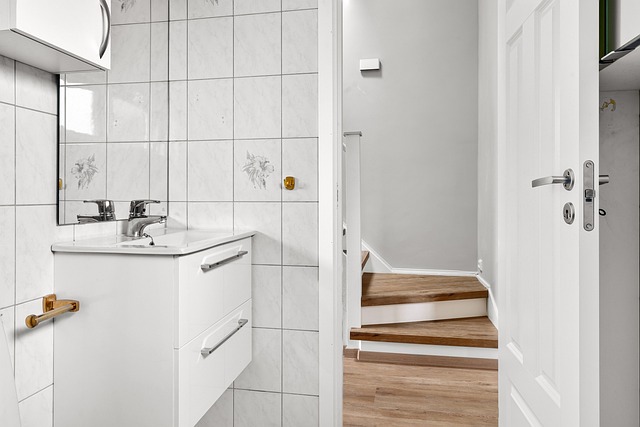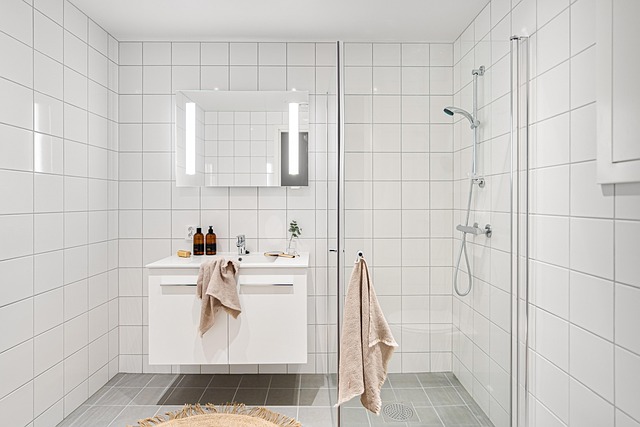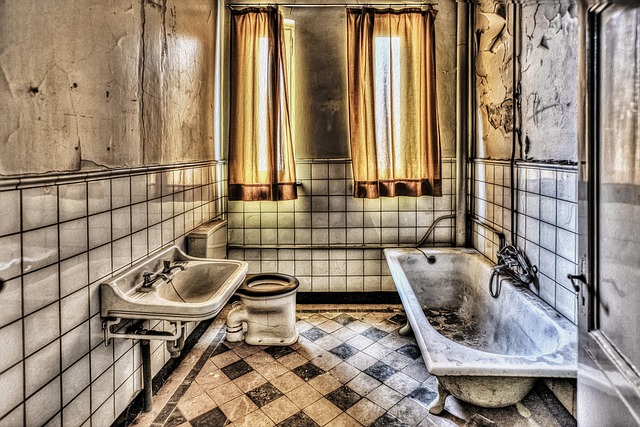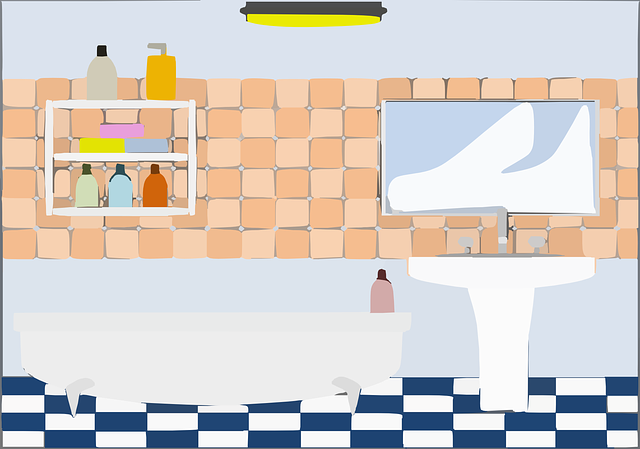Maximizing Space: Efficient Bathroom Storage Layouts and Solutions

In compact bathrooms, maximizing space is key to creating tranquil sanctuaries. This involves clever…….
Space-Saving Bathroom Layouts: Maximizing Functionality and Efficiency
Introduction
In the quest for optimal living spaces, especially in urban environments or homes with limited square footage, space-saving bathroom layouts have emerged as a critical solution. These designs not only enhance functionality but also add a touch of elegance to the smallest room in the house. This article delves into the intricacies of space-saving bathroom layouts, their significance, and how they are revolutionizing the way we think about bathroom design. Readers will learn about the core components, global trends, economic impact, technological advancements, and future prospects of these innovative designs.
Understanding Space-Saving Bathroom Layouts
Space-saving bathroom layouts refer to bathroom designs that optimize space without compromising on essential features or user comfort. These layouts are characterized by their compact size, smart storage solutions, and efficient use of available space. They often incorporate multifunctional elements, such as vanities with integrated storage or toilets designed to save space. The historical context of these layouts is rooted in the need for efficient housing solutions, particularly in densely populated areas where every square foot counts.
The significance of space-saving bathroom layouts lies in their ability to provide a functional and comfortable bathroom experience in limited spaces. They are particularly relevant in small apartments, homes with open floor plans, and multi-generational households where privacy and functionality are paramount. These layouts also cater to the growing trend of downsizing, as older adults prefer to age in place within smaller, more manageable homes.
Global Impact and Trends
The influence of space-saving bathroom layouts is felt worldwide, with different regions adapting these designs to suit local needs and preferences. In North America and Europe, the trend is towards minimalist designs that blend aesthetics with functionality. In Asia, where space is often at a premium, these layouts are not just a trend but a practical necessity. The global market for compact bathroom fixtures and fittings has seen significant growth, reflecting the increasing demand for such solutions.
Key trends shaping the trajectory of space-saving bathroom layouts include the integration of smart technology, eco-friendly materials, and sustainable design practices. The rise of digital technology has also led to virtual design tools that allow homeowners to visualize and plan their space-saving bathroom layouts before construction begins.
Economic Considerations
From a economic standpoint, space-saving bathroom layouts represent an investment in the future of housing. They contribute to the affordability of homes by reducing construction costs and increasing the number of units that can fit within a given area. The market dynamics for these layouts are influenced by demographic shifts, such as the rising number of single-person households and the trend towards urban living.
Investment patterns indicate a growing interest in properties that offer efficient use of space, with space-saving bathroom layouts being a key selling point. These layouts also play a role in economic systems by promoting sustainable development and reducing the environmental impact of construction and remodeling projects.
Technological Advancements
Technological advancements have significantly impacted space-saving bathroom layouts, with innovations ranging from water-saving fixtures to smart storage solutions. The integration of touchless faucets and toilets has not only saved space but also conserved water. The use of modular components allows for customization without compromising on the compact design.
In the future, we can expect even more sophisticated technologies, such as self-cleaning surfaces, voice-activated controls, and advanced waste management systems, to become standard in space-saving bathroom designs. These advancements will enhance user experience while maintaining the layout’s efficiency and aesthetics.
Policy and Regulation
Policies and regulations play a crucial role in shaping the development of space-saving bathroom layouts. Building codes and standards mandate minimum dimensions for fixtures, ventilation, and accessibility, which directly influence design choices. Sustainability regulations also drive the integration of eco-friendly materials and water-efficient fixtures.
At the international level, initiatives like the Leadership in Energy and Environmental Design (LEED) certification incentivize designers to incorporate sustainable features into their space-saving bathroom layouts. These policies and regulations are essential for ensuring that these layouts meet safety, health, and environmental standards while promoting innovation and efficiency.
Challenges and Criticisms
Despite their benefits, space-saving bathroom layouts face challenges and criticisms. One of the main concerns is maintaining a balance between functionality and design. Critics argue that in the pursuit of compactness, some designs may overlook user comfort and privacy. Additionally, there is a risk of overemphasizing aesthetics at the expense of practicality and accessibility.
To address these issues, designers and manufacturers must prioritize user-centered design principles, ensuring that space-saving bathroom layouts are not only visually appealing but also meet the needs of diverse users, including those with disabilities. Collaboration between industry professionals, policymakers, and end-users is essential to overcome these challenges and create inclusive and sustainable designs.
Conclusion
Space-saving bathroom layouts represent a forward-thinking approach to bathroom design that addresses the needs of a changing world. From economic considerations and global trends to technological advancements and policy impacts, these layouts are shaping the future of how we think about space in our homes. As we continue to innovate and adapt to new demands, space-saving bathroom designs will remain at the forefront of sustainable and efficient living solutions.
FAQs
What are space-saving bathroom layouts?
Space-saving bathroom layouts are designs that maximize the use of limited space without compromising on essential features or user comfort. They are characterized by smart storage solutions, multifunctional fixtures, and efficient spatial planning.
How do technological advancements impact space-saving bathroom layouts?
Technological advancements allow for more compact, efficient, and sustainable designs, with innovations such as touchless fixtures, modular components, and smart storage solutions enhancing both user experience and design efficiency.
What are the global trends in space-saving bathroom layouts?
Global trends include a move towards minimalist designs, integration of smart technology, use of eco-friendly materials, and sustainable practices. There is also a growing preference for virtual design tools that facilitate better planning and visualization of compact bathroom spaces.
How do policies and regulations affect space-saving bathroom layouts?
Policies and regulations set standards for safety, health, accessibility, and sustainability, which guide the design and implementation of space-saving bathroom layouts. Compliance with these standards ensures that the designs are not only functional but also environmentally responsible.
What are the challenges associated with space-saving bathroom layouts?
Challenges include balancing functionality with aesthetics, maintaining user comfort and privacy, and ensuring accessibility for all users. Overcoming these requires a user-centered approach and collaboration across various stakeholders in the design and building process.
References

In compact bathrooms, maximizing space is key to creating tranquil sanctuaries. This involves clever…….

Wall-mounted fixtures are a strategic design choice for optimizing cramped bathroom spaces. They max…….

Adopting a minimalist bathroom layout offers efficient storage and organization through strategic de…….

In compact homes, strategic design is key for space-saving bathroom layouts. These incorporate natur…….

Floating vanities are a smart, space-saving solution for small bathrooms, offering both aesthetic ap…….

Floating vanities have gained popularity as a modern bathroom design trend, offering both aesthetic…….

Compact bathrooms can be transformed into luxurious spaces through efficient bathroom storage soluti…….

Small bathroom design requires strategic planning to maximize limited space. Professional designers…….

Pocket doors for bathrooms are a sleek, space-saving solution that seamlessly slides into walls, eli…….

In urban areas with limited space, pocket doors for bathrooms are gaining popularity as an efficient…….